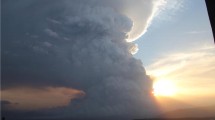Abstract
The Canadian fire weather index system (CFFWIS) has been adopted for fire danger rating throughout Europe as part of the European Forest Fire Information System. However, its performance has not been thoroughly assessed, especially in environments less prone to fire. In this study, we characterised fire activity between 1995 and 2009 in the sub-Mediterranean Karst forest management area of SW Slovenia. Five fire danger classes (very low, low, moderate, high and very high) were derived from percentile analysis of the CFFWIS Fire Weather Index. These classes were found to be related with fire activity descriptors. Logistic regression prediction of fire-days based on CFFWIS indices had low accuracy, and better discrimination was achieved by classification tree modelling. Fire activity was found to be driven by current weather conditions rather than by drought. Our findings highlight the potential of fire danger rating to guide fire management but also the limitations imposed by relatively low incidence of fire and the spatial scale of analysis.


Similar content being viewed by others
References
Alexander ME (1994) Proposed revision of fire danger class criteria for forest and rural areas in New Zealand. NRFA/NZFRI, Circular 1994/2, Wellington
Amiro BD, Logan KA, Wotton BM, Flannigan MD, Todd JB, Stocks BJ, Martell DL (2004) Fire weather index system components for large fires in the Canadian boreal forest. Int J Wildland Fire 13:391–400
Andrews PL, Loftsgaarden DO, Bradshaw LS (2003) Evaluation of fire danger rating indexes using logistic regression and percentile analysis. Int J Wildland Fire 12:213–226
Camia A, Amatulli G (2009) Weather factors and fire danger in the Mediterranean. In: Chuvieco E (ed) Earth observation of wildland fires in Mediterranean ecosystems. Springer, Berlin, pp 71–82
Camia A, Barbosa P, Amatulli G, San-Miguel-Ayanz J (2006) Fire danger rating in the European forest fire information system (EFFIS): current developments. For Ecol Manage S234:S20
Carvalho A, Flannigan MD, Logan K, Miranda AI, Borrego C (2008) Fire activity in Portugal and its relationship to weather and the Canadian fire weather index system. Int J Wildland Fire 17:328–338
De’ath C, Fabricius K (2000) Classification and regression trees: a powerful yet simple technique for ecological data analysis. Ecology 81:3178–3192
Dimitrakopoulos AP, Bemmerzouk AM, Mitsopoulos ID (2010) Evaluation of the Canadian fire weather index system in an eastern Mediterranean environment. Met App. doi:10.1002/met.214
Fernandes PM (2008) Forest fires in Galicia (Spain): the outcome of unbalanced fire management. J For Econ 14:155–157
Fujioka FM, Gill AM, Viegas DX, Wotton BM (2009) Fire danger and fire behavior modeling systems in Australia, Europe and North America. In: Bytnerowicz A, Arbaugh M, Riebau A, Andersen C (eds) Wildland fires and air pollution. Developments in environmental science, vol 8. Elsevier, Amsterdam, pp 471–498
Harrington JB, Flannigan MD, Van Wagner CE (1983) A study of the relation of components of the fire weather index to monthly provincial area burned by wildfire in Canada 1953–1980. Inf. Rep. PI-X-25, Environ. Can., Can. For. Serv., Petawawa Natl. For. Inst. Chalk River, ON
Helfman RS, Straub RJ, Deeming JE (1987) User’s guide to AFFIRMS: time-share computerized processing for fire danger rating. USDA Forest Service, Intermountain Research Station, Gen. Tech. Rep. INT-82. Ogden, UT
Hosmer DW, Lemeshow S (2000) Applied logistic regression, 2nd edn. Wiley, New York
Jakša J (1997) Obseg in posledice gozdni požarov v Sloveniji v letih 1991 do 1996 ter vloga gozdarstva v varstvu pred požari v gozdu. Gozdarski Vestnik 97:386–395
Kiil AD, Miyagawa RS, Quintilio D (1977) Calibration and performance of the Canadian fire weather index in Alberta. Environ. Can., Can. For. Serv., North. For. Res. Cent., Inf. Rep. NOR-X-173. Edmonton, AB
Kobler A, Ogrinc P, Fajfar D, Džeroski S (2006) Končno poročilo o rezultatih raziskovalnega projekta: napovedovalni GIS model požarne ogroženosti naravnega okolja, ciljni raziskovalni program: znanje za varnost in mir 2004–2010. Inštitut Jožef Štefan, Gozdarski inštitut Slovenije, IGEA
Parisien MA, Hirsch KG, Lavoie SG, Todd JB, Kafka VG (2004) Saskatchewan fire regime analysis. Can. For. Serv., North. For. Cent., Inf. Rep. NOR-X-394. Edmonton, AB
Pečenko A (1994) Določanje stopenj požarne ogroženosti naravnega okolja v Sloveniji. Ujma 8:193–196
Rainha M, Fernandes PM (2002) Using the Canadian fire weather index (FWI) in the Natural Park of Montesinho, NE Portugal: calibration and application to fire management. In: Viegas D (ed) Proceedings of the IV International Conference on forest fire research, Luso, Portugal
Reinhard M, Rebetez M, Schlaepfer R (2005) Recent climate change: rethinking drought in the context of forest fire research in Ticino, south of Switzerland. Theor Appl Climatol 82:17–25
SFS (2003) Gozdnogospodarski načrt Kraškega gozdnogospodarskega območja 2001–2010. Slovenia Forest Service, RU Sežana
Taylor SW, Alexander ME (2006) Science, technology, and human factors in fire danger rating: the Canadian experience. Int J Wildland Fire 15:121–135
Van Wagner CE (1987) Development and structure of the Canadian forest fire weather index system. Can. For. Serv., For. Tech. Rep. 35, Ottawa, ON
Viegas DX, Bovio G, Ferreira A, Nosenzo A, Sol B (1999) Comparative study of various methods of fire danger evaluation in southern Europe. Int J Wildland Fire 10:235–246
Vučetić M, Vučetić V, Španjol Ž, Barčić D, Rosavec R, Mandić A (2006) Secular variations of monthly severity rating on the Croatian Adriatic coast during the forest fire season. For Ecol Manage 234:S251
Acknowledgments
The first author acknowledges financial support in the context of a short-term scientific mission under the COST Action FP0701 (Post-fire Forest Management in Southern Europe). Samantha Jane-Hughes revised the text for grammar. We thank the reviewers for their constructive comments.
Author information
Authors and Affiliations
Corresponding author
Additional information
Communicated by G. Brazaitis.
Rights and permissions
About this article
Cite this article
Šturm, T., Fernandes, P.M. & Šumrada, R. The Canadian fire weather index system and wildfire activity in the Karst forest management area, Slovenia. Eur J Forest Res 131, 829–834 (2012). https://doi.org/10.1007/s10342-011-0556-7
Received:
Revised:
Accepted:
Published:
Issue Date:
DOI: https://doi.org/10.1007/s10342-011-0556-7




